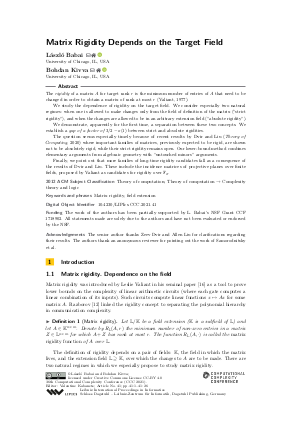Matrix Rigidity Depends on the Target Field
Authors
László Babai  ,
Bohdan Kivva
,
Bohdan Kivva 
-
Part of:
Volume:
36th Computational Complexity Conference (CCC 2021)
Part of: Series: Leibniz International Proceedings in Informatics (LIPIcs)
Part of: Conference: Computational Complexity Conference (CCC) - License:
 Creative Commons Attribution 4.0 International license
Creative Commons Attribution 4.0 International license
- Publication Date: 2021-07-08
File

PDF
LIPIcs.CCC.2021.41.pdf
- Filesize: 0.87 MB
- 26 pages
Document Identifiers
Subject Classification
ACM Subject Classification
- Theory of computation
- Theory of computation → Complexity theory and logic
Keywords
- Matrix rigidity
- field extension
Metrics
- Access Statistics
-
Total Accesses (updated on a weekly basis)
0PDF Downloads0Metadata Views
Abstract
The rigidity of a matrix A for target rank r is the minimum number of entries of A that need to be changed in order to obtain a matrix of rank at most r (Valiant, 1977).
We study the dependence of rigidity on the target field. We consider especially two natural regimes: when one is allowed to make changes only from the field of definition of the matrix ("strict rigidity"), and when the changes are allowed to be in an arbitrary extension field ("absolute rigidity").
We demonstrate, apparently for the first time, a separation between these two concepts. We establish a gap of a factor of 3/2-o(1) between strict and absolute rigidities.
The question seems especially timely because of recent results by Dvir and Liu (Theory of Computing, 2020) where important families of matrices, previously expected to be rigid, are shown not to be absolutely rigid, while their strict rigidity remains open. Our lower-bound method combines elementary arguments from algebraic geometry with "untouched minors" arguments.
Finally, we point out that more families of long-time rigidity candidates fall as a consequence of the results of Dvir and Liu. These include the incidence matrices of projective planes over finite fields, proposed by Valiant as candidates for rigidity over 𝔽₂.
Cite As Get BibTex
László Babai and Bohdan Kivva. Matrix Rigidity Depends on the Target Field. In 36th Computational Complexity Conference (CCC 2021). Leibniz International Proceedings in Informatics (LIPIcs), Volume 200, pp. 41:1-41:26, Schloss Dagstuhl – Leibniz-Zentrum für Informatik (2021)
https://doi.org/10.4230/LIPIcs.CCC.2021.41
BibTex
@InProceedings{babai_et_al:LIPIcs.CCC.2021.41,
author = {Babai, L\'{a}szl\'{o} and Kivva, Bohdan},
title = {{Matrix Rigidity Depends on the Target Field}},
booktitle = {36th Computational Complexity Conference (CCC 2021)},
pages = {41:1--41:26},
series = {Leibniz International Proceedings in Informatics (LIPIcs)},
ISBN = {978-3-95977-193-1},
ISSN = {1868-8969},
year = {2021},
volume = {200},
editor = {Kabanets, Valentine},
publisher = {Schloss Dagstuhl -- Leibniz-Zentrum f{\"u}r Informatik},
address = {Dagstuhl, Germany},
URL = {https://drops.dagstuhl.de/entities/document/10.4230/LIPIcs.CCC.2021.41},
URN = {urn:nbn:de:0030-drops-143153},
doi = {10.4230/LIPIcs.CCC.2021.41},
annote = {Keywords: Matrix rigidity, field extension}
}
Author Details
Funding
The work of the authors has been partially supported by L. Babai’s NSF Grant CCF 1718902. All statements made are solely due to the authors and have not been evaluated or endorsed by the NSF.
Acknowledgements
The senior author thanks Zeev Dvir and Allen Liu for clarifications regarding their results. The authors thank an anomymous reviewer for pointing out the work of Samorodnitsky et al.
References
- Josh Alman. Kronecker products, low-depth circuits, and matrix rigidity. In Proc. 53rd ACM Symp. on Theory of Computing (STOC'21), pages 772-785, 2021. https://arxiv.org/abs/2102.11992. URL: https://doi.org/10.1145/3406325.3451008.
- Josh Alman and Ryan Williams. Probabilistic rank and matrix rigidity. In Proc. 49th STOC, pages 17:1-17:23. ACM Press, 2017. URL: https://doi.org/10.1145/3055399.3055484.
- Zeev Dvir and Benjamin Edelman. Matrix rigidity and the Croot-Lev-Pach lemma. Theory of Computing, 15(8):1-7, 2019. URL: https://doi.org/10.4086/toc.2019.v015a008.
- Zeev Dvir and Allen Liu. Fourier and circulant matrices are not rigid. Theory of Computing, 16(20):1-48, 2020. URL: https://doi.org/10.4086/toc.2020.v016a020.
- Joel Friedman. A note on matrix rigidity. Combinatorica, 13(2):235-239, 1993. URL: https://doi.org/10.1007/BF01303207.
- Oded Goldreich and Avishay Tal. Matrix rigidity of random Toeplitz matrices. Comput. Complexity, 27(2):305-350, 2018. Preliminary version in https://doi.org/10.1145/2897518.2897633. URL: https://doi.org/10.1007/s00037-016-0144-9.
-
Robin Hartshorne. Algebraic geometry. Graduate texts in mathematics (52) Springer, 1977.

- Bohdan Kivva. Improved upper bounds for the rigidity of Kronecker products. arXiv, 2021. URL: http://arxiv.org/abs/2103.05631.
-
Serge Lang. Algebra, volume 211 of Grad. Texts in Math. Springer, 3rd edition, 1996.

- Satyanarayana V. Lokam. On the rigidity of Vandermonde matrices. Theoret. Comput. Sci., 237(1-2):477-483, 2000. URL: https://doi.org/10.1016/S0304-3975(00)00008-6.
- Satyanarayana V. Lokam. Quadratic lower bounds on matrix rigidity. In Internat. Conf. on Theory and Appl. of Models of Computation (TAMC'06), pages 295-307. Springer, 2006. URL: https://doi.org/10.1007/11750321_28.
-
Alexander Razborov. On Rigid Matrices. Technical report, Steklov Mathematical Institute, 1989.

-
Alex Samorodnitsky, Ilya Shkredov, and Sergey Yekhanin. Kolmogorov width of discrete linear spaces: an approach to matrix rigidity. Computational Complexity, 25(2):309-348, 2016.

- Mohammad Amin Shokrollahi, Daniel A. Spielman, and Volker Stemann. A remark on matrix rigidity. Inform. Process. Lett., 64(6):283-285, 1997. URL: https://doi.org/10.1016/S0020-0190(97)00190-7.
-
Victor Shoup and Roman Smolensky. Lower bounds for polynomial evaluation and interpolation. Computational Complexity, 6(4):301-311, 1997.

- Leslie G. Valiant. Graph-theoretic arguments in low-level complexity. In Math. Found. Comp. Sci. (MFCS'77), pages 162-176. Springer, 1977. URL: https://doi.org/10.1007/3-540-08353-7_135.
